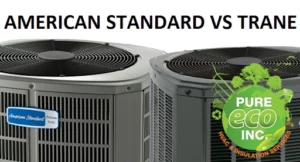When it comes to maximizing energy efficiency and reducing heat loss in your home, proper insulation in the attic plays a crucial role. Attic insulation helps maintain a comfortable indoor temperature, saves energy, and lowers utility bills. However, determining the right amount of insulation can be a daunting task.
This article explains the factors that influence the required insulation level and provides insights into achieving optimal energy efficiency. Whether you’re considering new insulation or evaluating your current setup, this guide will help you make informed decisions for a well-insulated attic.
The Importance of Attic Insulation
Understanding the benefits of insulation will motivate you to assess your attic and take necessary measures for optimal energy efficiency. Attic insulation is essential for several reasons.
First, it acts as a barrier, preventing heat from escaping during colder months and entering during warmer months.
In addition, adequate insulation reduces the workload on your heating and cooling systems, resulting in lower energy consumption and utility bills.
Lastly, insulation helps maintain a consistent temperature throughout your home, enhancing comfort and reducing drafts.
Factors to Consider
To determine how much insulation you need in your attic, you should consider several factors, from the local climate and the insulation’s R-Value to your existing insulation.
Home age and construction
Older homes may have less insulation than newer ones, as building codes have changed over time. The type of construction can also impact insulation needs.
The design and layout of your home can impact insulation needs, as some styles of homes can be more challenging to insulate. For example, houses with cathedral ceilings or homes with a lot of attic space may need more insulation, while smaller or more compact homes may need less. The quality and insulation of your windows and doors can also affect the overall insulation needs of your home.
HVAC systems and ventilation
The location and efficiency of your heating, ventilation, and air conditioning (HVAC) systems can also impact how much insulation you need. For example, if your HVAC system is located in the attic, you might need more insulation to protect it from extreme temperatures.
Proper attic ventilation is crucial as well, because it allows moisture to escape and helps maintain a steady temperature in the attic. Insufficient ventilation can lead to moisture problems that degrade insulation effectiveness.
Climate and region
The amount of insulation needed depends on the climate zone and the specific region where your home is located. Colder climates generally require higher insulation levels to combat heat loss.
R-Value
Insulation levels are specified by R-Value, which measures the insulation’s resistance to heat flow. The higher the R-Value, the better the insulation’s effectiveness. The recommended level of insulation varies depending on where you live because different climates require different levels of insulation.
The U.S. Department of Energy provides a zone map and recommended R-Values for insulation in different areas of the home, including the attic. Zones 1 & 2 (e.g., Miami, Houston) require R30 to R49.
To check the current level of insulation in your attic, you can measure the thickness of the insulation with a ruler and identify the type of insulation (fiberglass, cellulose, etc.). Each type of insulation has a different R-value per inch:
- Fiberglass batts: R-3.2 to R-3.8 per inch
- Fiberglass blown: R-2.2 to R-2.9 per inch
- Cellulose blown: R-3.2 to R-3.8 per inch
- Spray foam: Varies greatly but can be up to R-6.5 per inch
So, if you have 10 inches of fiberglass batts insulation, your approximate R-Value would be 32 to 38 (10 inches times R-3.2 to R-3.8 per inch). If this is below the recommended level for your climate zone, you should consider adding more insulation.
Existing insulation
Evaluate your attic’s current insulation. If it’s insufficient, damaged, or outdated, you’ll need to add more insulation to achieve the recommended R-value.
Type of insulation
Various insulation materials are available, such as fiberglass, cellulose, and spray foam. Each material has different insulating properties, costs, and installation requirements. Consider the pros and cons of each type before making a decision.
Accessibility
The ease of accessing your attic affects the insulation installation process. If your attic is challenging to reach, you may require professional assistance.
Determining the Required Insulation Level
To calculate the amount of insulation needed for your attic, you should first consider your energy efficiency goals. If you want to maximize energy efficiency and minimize utility costs, you may choose to install more insulation than the minimum recommended R-value for your area. You can consult the DOE guidelines or local building codes for recommended R-values in your region.
You then need to check your local building codes. Some municipalities may have specific building codes that require a certain level of insulation.
The next step is to measure the depth of your current insulation using a ruler or tape measure. Take multiple measurements in different areas to account for any variations and calculate the additional insulation needed. To do so, subtract the measured depth from the recommended R-value for your region. This will give you the additional inches of insulation required. Adjust the calculation based on the specific R-value of the material you choose.
If the above seems too complex or you prefer expert advice, consider contacting insulation professionals who can assess your attic and recommend the appropriate insulation levels.
Insulation Installation Tips
Depending on your skills, comfort level, and attic accessibility, you can install insulation yourself or hire a professional. DIY installation requires caution and adherence to safety guidelines. Always wear the proper safety gear when installing insulation, including a dust mask, safety glasses, gloves, and long sleeves and pants to protect your skin from irritation.
Before you install insulation, ensure that your attic is properly sealed to prevent air leaks. Seal up any air leaks with caulk or expanding foam, including any gaps, cracks, and areas around pipes, vents, and electrical wiring. This step enhances insulation effectiveness and helps ensure that your insulation can do its job properly. Insulation is just one part of a system to keep your house energy efficient. Air sealing is also important because insulation won’t be as effective if there are air leaks.
Also, be sure to choose the right insulation for the job. Different types of insulation are suited to different applications. For example, rolls and batts or loose-fill insulation are well-suited to attic floors, while rigid foam boards and spray foam might be used for the attic roof.
When it’s time to install the insulation, be careful not to compress it. Insulation works by trapping air. If it’s compressed, it won’t be as effective. Lay insulation down flat and don’t stuff it into spaces. Be careful not to block soffit vents with insulation. Proper ventilation helps control moisture and prevent the buildup of mold and mildew.
While installing the insulation, be sure to cover everything. Insulation should be installed evenly over the entire attic floor, including the tops of the joists. Make sure there are no gaps or uncovered areas. If the existing insulation doesn’t reach the top of your joists, you can layer additional insulation perpendicular to the joists until you reach the desired R-value. Just be careful around light fixtures and other equipment. Recessed light fixtures can be a fire hazard if they come into contact with insulation unless they’re IC-rated (insulation contact).
Why Hire Pure Eco for Your Attic Insulation?
Determining the right amount of insulation for your attic is essential for maximizing energy efficiency and reducing heat loss in your home. Factors such as climate, recommended R-values, existing insulation, and insulation types all play a crucial role in making informed decisions.
By following the guidelines provided by the Department of Energy and considering professional advice when needed, you can ensure your attic is properly insulated. Remember that a well-insulated attic not only saves energy and lowers utility bills but also enhances comfort and reduces drafts throughout your home.
Of course, every home is unique, and what works best in your situation might be different from what works for someone else. Your ultimate goal should be to create an energy-efficient, comfortable home environment.
If you’re not comfortable taking on the task of insulating your attic yourself or if your attic has complex needs (like a pest infestation or mold problem), consider hiring a professional.
Call Pure Eco Inc. today at (877) 870-7998 and ask for your free attic insulation quote. Don’t forget to request your free Home Comfort Estimate!





